
COURSEWORK
Mithun's CL-CY-001 course work. Lv 3
| Mithun Srinivas | AUTHOR | ACTIVE |

Mithun'S General tasks report
8 / 7 / 2024
MARVEL BATCH 5-MITHUN SRINIVAS
GENERIC TASKS---
TASK 1:3D PRINTING
In this task I learn about the type of printing i.e, FMD and the file that represent the model which is STL.I also learn about the settings in support and temperature.3D printers create physical objects layer-by-layer from a digital model.It melts the plastic filament “PLA”and deposits it according to the instructions from the slicing software.

It was a fun task to print a pokemon in less than 2 hours!
.png)
Key learnings:
- Learnt about the PLA setting and the slicer settings
- The extruder temperature of the PLA should be 200 degrees of PLA
- The bed temperature should be 50-60C
- Learnt about G CODE and STL file
TASK 2:API
API stands for Application Programming Interface, acts as a middleman between two software applications. It provides a set of rules and specifications that allow programs to communicate with each other and exchange data or functionality.
There are two types of API:
Data APIs: These APIs provide access to specific data sets or information. For example, a weather API might provide access to real-time weather data for a particular location.
Functional APIs: These APIs allow applications to call upon specific functionalities offered by another service. For instance, a mapping API might provide functionalities for displaying interactive maps within an application.Imade weather app using api key and javascript
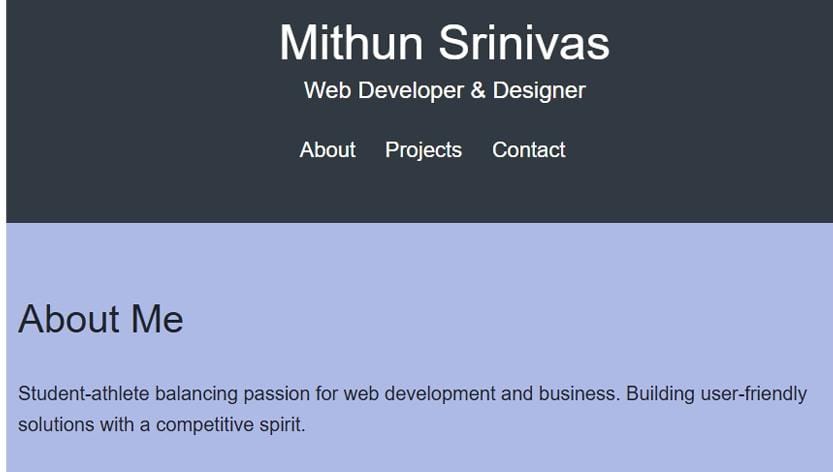
AJAX (Asynchronous JavaScript and XML) is a powerful technique used to make requests to servers and retrieve data without reloading the entire webpage. This allows for a more dynamic and user-friendly web experience.
Key Learnings:
- Understood the concept of API
- Learnt the types of APIs
- Create an API key for weather forecast
- Learnt about AJAX
- XMLHttpRequest And JSon(JavaScript Object Notation) are the main components that make APIs work successfully
TASK 3:WORKING WITH GITHUB
The objective was to get familiar with github
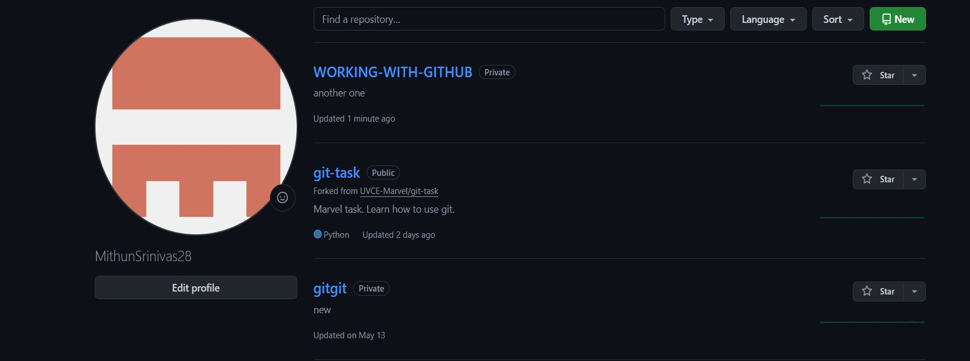
Key learnings:
- I installed Githuband Git.I forked a file from the reference and created a new repository in my profile
- I made the changes in the given program and worked on the operations like pull requests ,Forking and repository
TASK 4: UBUNTU
It is a free operating system that is used in major data repository. Getting in command with ubuntu taught me many commands like which are used to create a folder or store some information in that folder.
I struggled at first but eventually gained a good insight into how to use the command line interface. I completed the task to create a folder, cd into the folder, list files in that folder and create 2600 new folders in that folder

Key Learnings:
- To open the ubuntu terminal- Ctrl + Alt + T
- Use mkdir to create a folder
- The cd command(change directory) for is used to navigate to the directory
- The touch command is used to create new files
- The ls command is used to display the info or the file.
- pwd (print working directory). This command displays your current working
TASK 5: KAGGLE CONTEST
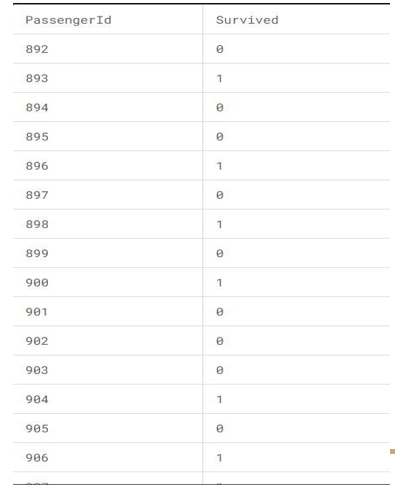
Key Learnings:
- CSV (Comma-Separated Values)which is used for storing tabular data in a plain text format
- Choosing the right model and strategy for any problem
- Creating a notebook
- Using .loc to select rows and columns based on their names.
- .assign it creates new dataframe by modifying the existing one
- Brief Idea about Ensemble

TASK 7:CREATE A PORTFOLIO WEBSITE
 The objective was to create a portfolio using HTML and CSS.With the help of AI I created a simple website and Used VS code as the platform to code
The objective was to create a portfolio using HTML and CSS.With the help of AI I created a simple website and Used VS code as the platform to code
Key Learnings:
- Revised html and CSS concepts and keywords.
TASK 8:WRITE A REPORT USING MARKDOWN
File corrupted
TASK 9: TINKERCAD
I got familiar with tinkercad and its interface.I did several circuits with it and tried multiple tools and components with different codes
Created a radar system utilizing an ultrasonic sensor and servo motor to detect objects within a certain range.
The ultrasonic sensor emits sound waves and measures the time taken for them to bounce back, while the servo motor rotates the sensor to cover a wider area, providing a simple yet effective detection mechanism

TASK 10: SPEED CONTROL OF DC MOTOR USING UNO AND L298N
About main components L298N:
The L298N is a dual H-bridge integrated circuit (IC) commonly used for controlling DC motor direction and speed with an Arduino board.It can handle two DC motor and one bipolar stepper motor.By applying different logic signals (HIGH or LOW) to these pins, you can control the direction of rotation and enable/disable the motor.
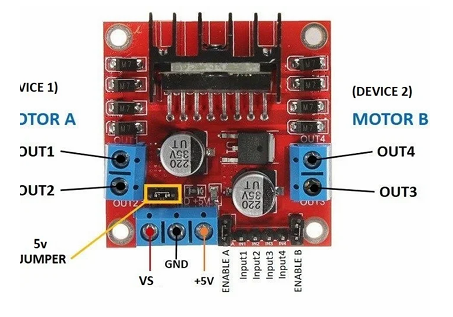
Arduino:
It is a circuit board which allows the user to program inorder to control the electronic components like DC motors.
It helps in the method of Pulse Width Modulation which is a technique where a digital signal rapidly switches between on and off states.The ratio of the on time to the total cycle time (period) determines the average voltage delivered to the motor.By varying the pulse width using Arduino's PWM pins, we can control the average voltage supplied to the motor, thereby affecting its speed.

Other components
- DC Motor (voltage and current rating compatible with L298N)
- Jumper Wires
- Power Supply (voltage suitable for your motor)
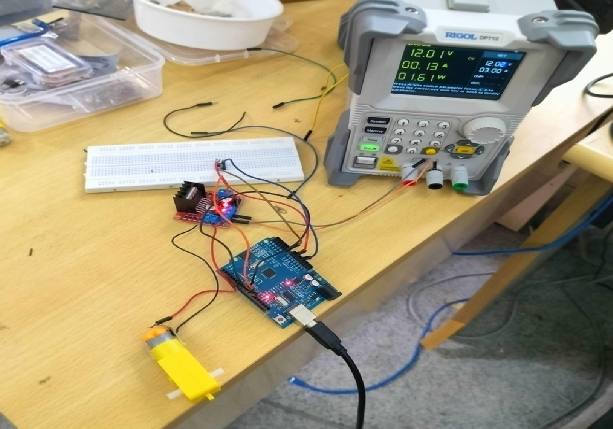
Key Learnings:
- I learnt about the L28N and Arduino Uno briefly
- Learnt how to control the speed of the dc motor
- Learnt how to use the breadboard
- Additionally learnt another way of speed controlling i.e. varying voltage supply
- Added the code to the uno using C++
TASK 12:SOLDERING
It is process of joining two metals using a filler.This process is commonly used in electronics to solder components like pins and wires in order to keep the circuit closed
I soldered a led bulb into the circuit board
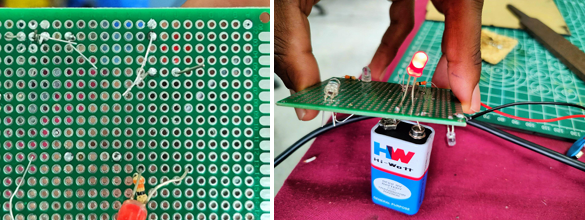
TASK 13: 555 IC TIMER
The IC timer is a integrated circuit which is used a s an oscillator,timer and pulse width modulation signals.The objective was to obtain 60% duty output and observe the output on the DSO(oscilloscope).I meade the required connections as shown by the reference using the breadboard and jumper wires
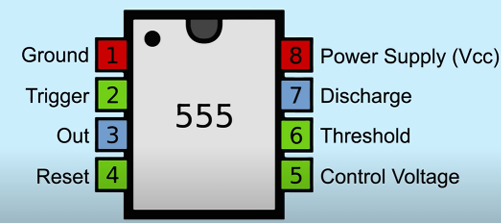
Ground (GND): Connects to circuit's ground like negative on a battery. Trigger (TRG): Starts the timer in one-shot mode or influences it in others. Output (OUT): Where the timer signal comes out (pulse, wave, or on/off). Reset (RESET): Pushes the timer to stop and clear, like a big red button.
Control (CTRL): Fine-tune timing speed in some modes
Threshold (THR): Works with trigger to set the timing finish line.
Discharge (DIS): Helps clear the timer after a pulse or offers advanced control.
Power (VCC): Plugs the chip in, like connecting it to a power source.
OTHER COMPONENTS:
COMPARATORS: It is a device that compares voltage of the inputs and outputs indicating whichever of its input is larger
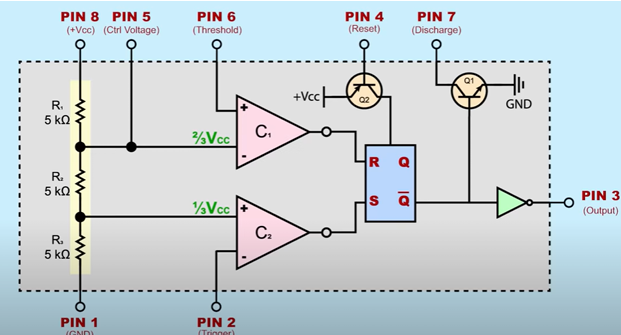

This is the logic circuit inside the IC
Key learnings:
I studied the components and the logic behind an 555 IC and its uses.Made the connections as provided in the reference and got the output

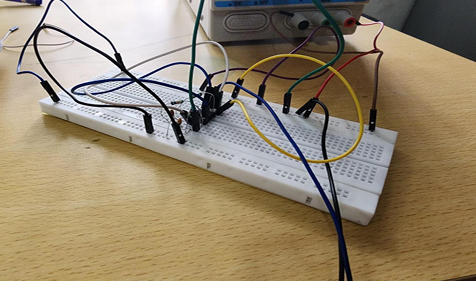
TASK 14:KARNAUGH MAPS AND DERIVING LOGIC CIRCUITS
Karnaugh Maps (abbreviated as K-maps) are graphical techniques used to simplify boolean expressions and derive the logic circuit for a given truth table. They have been invaluable in digital logic design and problem solving.
As given for 4 cases I used doors open and close and key pressed and not pressed and 2 different categories.I constructed a truth table and applied logic gates
THE RESULT OBTAINED WAS A XOR GATE
This is the logic used in burglar alarm
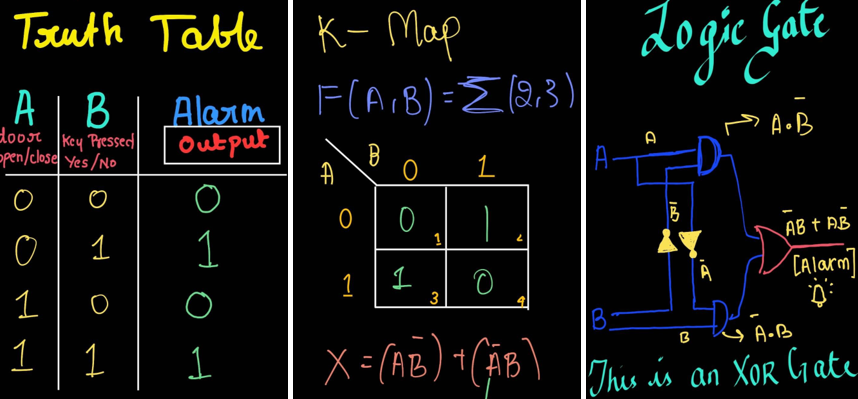
TASK 15:
Active participation is the main objective
- I have attended several seminars
- I started to learn python from youtube
- I also participated in Impetus Events